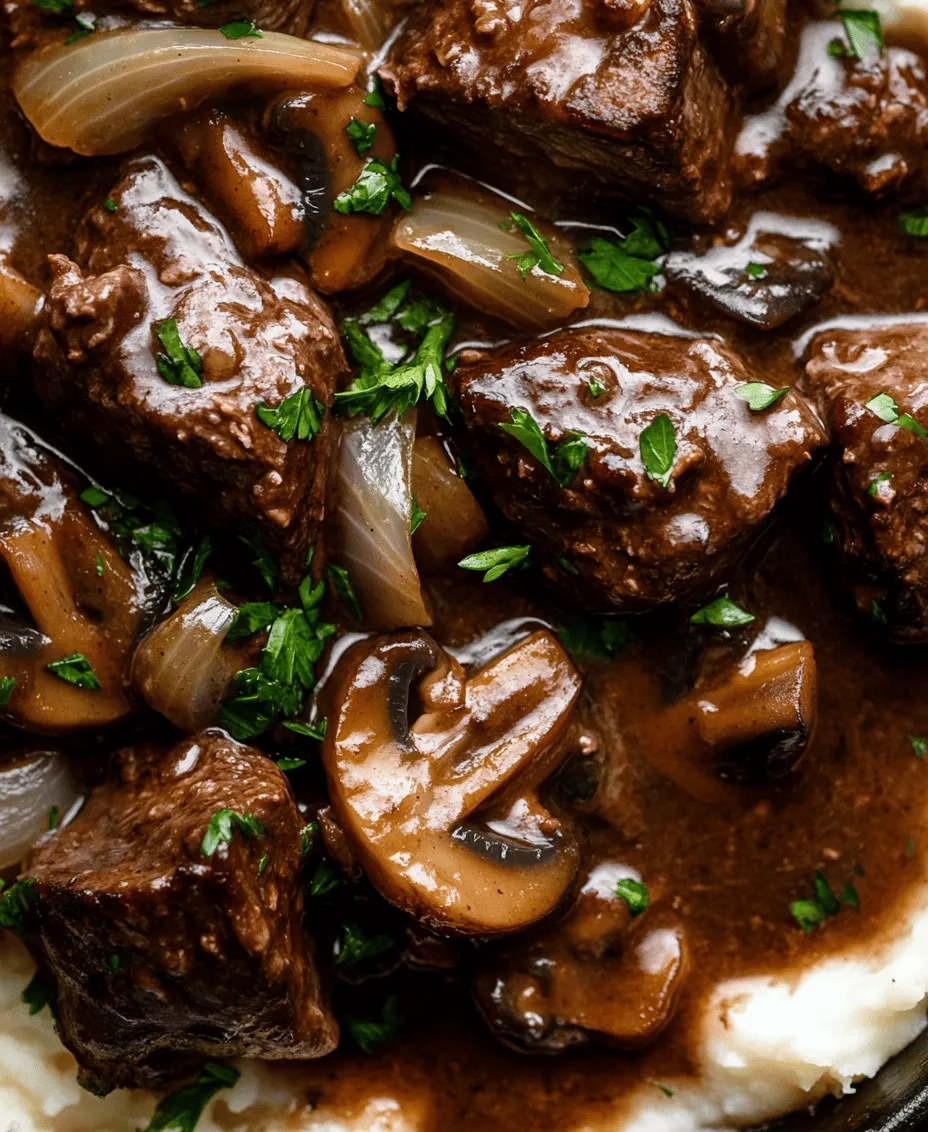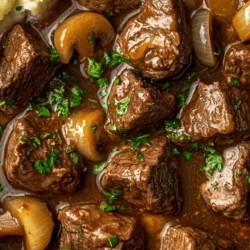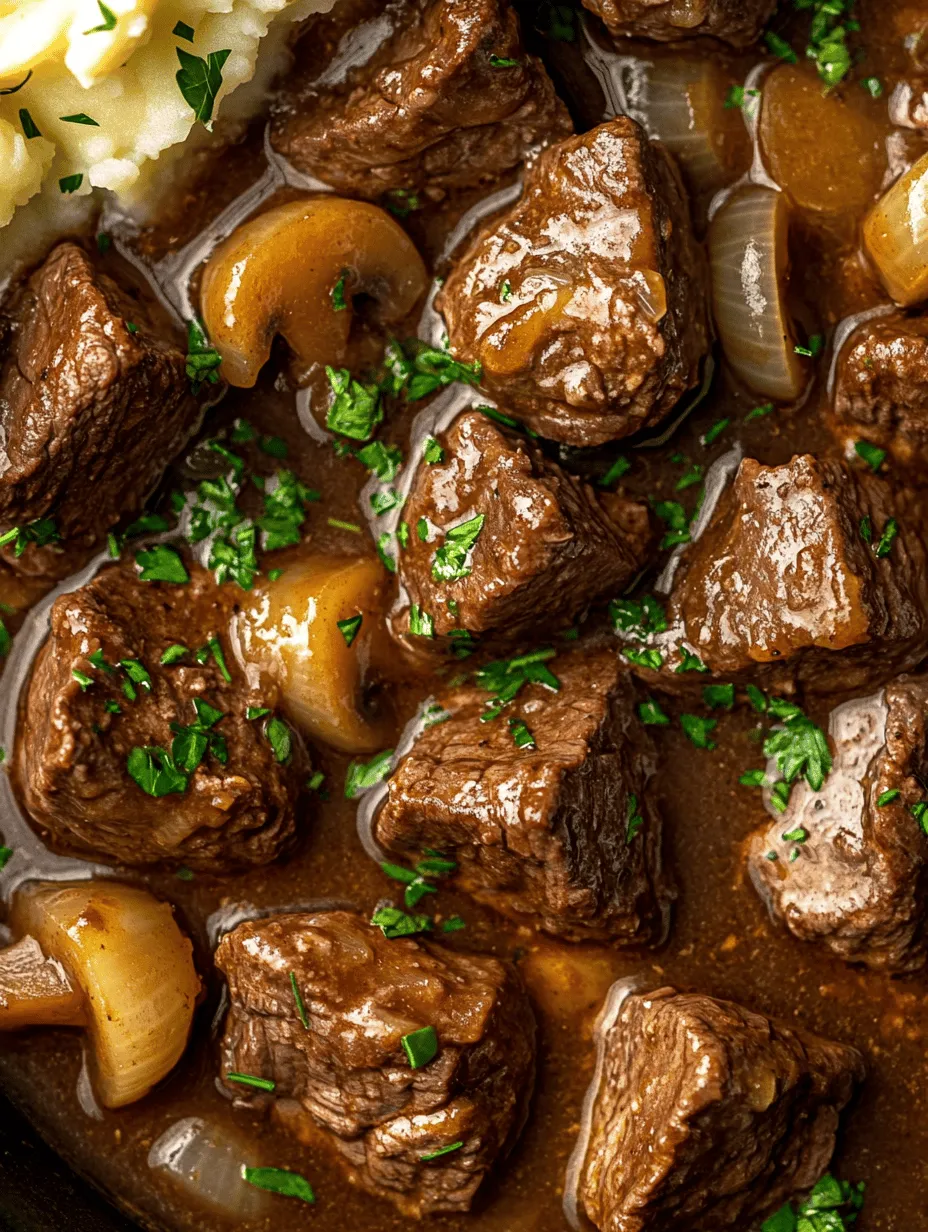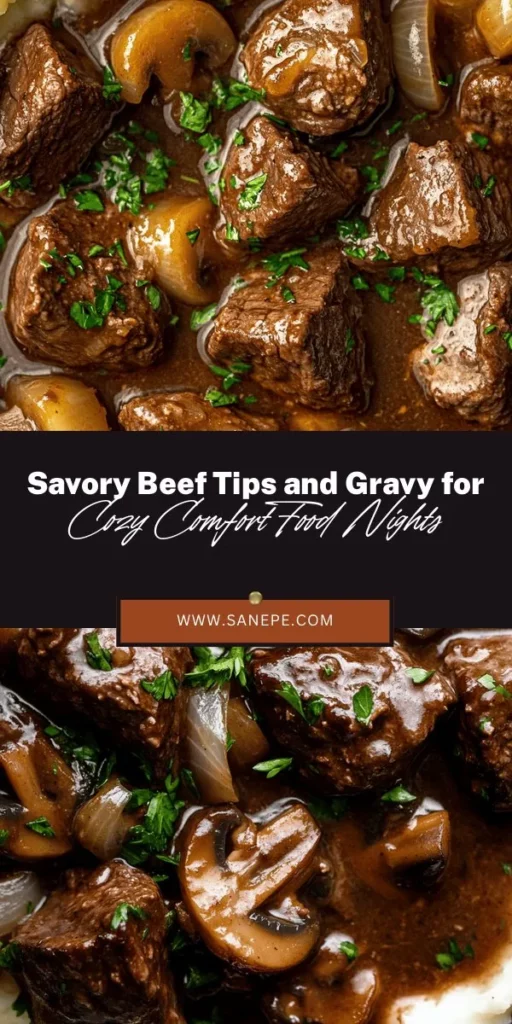Introduction
In the realm of home cooking, few dishes resonate as deeply as a hearty plate of savory beef tips and gravy. This comforting meal not only warms the heart but also fills the stomach, making it a staple for family gatherings and cozy weeknight dinners alike. The rich, succulent flavors of tender beef tips simmered in a luscious gravy create a delightful experience that brings everyone to the table.
Comfort food, in its essence, is about more than just satisfying hunger; it evokes nostalgia and warmth, often reminding us of cherished moments spent with family. The savory beef tips and gravy delight encapsulates this sentiment perfectly, promising a delicious meal that feels like a warm embrace. With each bite, you’re treated to a medley of flavors, from the robust taste of quality beef to the aromatic embrace of garlic and onion, all enhanced by the subtle earthiness of mushrooms.
As we delve into this recipe, you will discover the key ingredients that contribute to the dish’s appeal, along with the essential techniques that elevate it from ordinary to extraordinary.
The Allure of Savory Beef Tips
Beef tips, typically cut from the tenderloin or sirloin, are celebrated for their rich flavor and tenderness. Originating as a way to make use of less desirable cuts of meat, beef tips have evolved into a beloved component of numerous culinary traditions. They can be found in a variety of preparations around the world, from classic American dishes to international fare, each bringing its unique twist to this versatile ingredient.
In addition to their delectable flavor, beef sirloin and tenderloin are packed with nutritional benefits. Both cuts are excellent sources of high-quality protein, essential for muscle development and overall health. They also contain important vitamins and minerals, including B vitamins, iron, and zinc, which play vital roles in energy production and immune function. This combination of taste and nutrition makes savory beef tips a perfect choice for family meals, where satisfaction and health go hand in hand.
Comfort food often plays a central role in family meals, serving as a conduit for connection and celebration. Whether it’s a chilly winter evening or a special occasion, savory beef tips and gravy can transform an ordinary dinner into a memorable experience, encouraging laughter, conversation, and togetherness.
Ingredients Breakdown
To craft the perfect savory beef tips and gravy delight, you’ll need a selection of high-quality ingredients, each playing its role in developing the dish’s rich flavor profile. Below is an overview of the primary components and their significance.
Beef Sirloin or Tenderloin: Quality and Selection Tips
The heart of the dish lies in the beef tips themselves. Choosing the right cut is crucial for achieving the best flavor and texture. Sirloin is often favored for its balance of tenderness and flavor, while tenderloin is renowned for its buttery softness. When selecting beef, look for cuts that are bright red with a good amount of marbling. Marbling refers to the small flecks of fat within the muscle, which contribute to the meat’s juiciness and flavor. Always aim for grass-fed or organic options if possible, as these tend to offer a richer taste and are generally considered healthier.
Olive Oil: Health Benefits and Cooking Properties
Next, we have olive oil, a staple in many kitchens worldwide. Not only does it impart a delicious flavor, but it also boasts numerous health benefits. Rich in monounsaturated fats, olive oil has been linked to improved heart health and reduced inflammation. When cooking beef tips, using olive oil is ideal due to its high smoke point, which allows for perfect searing without burning. A drizzle of this golden oil not only enhances the beef’s natural flavors but also helps achieve the desirable browning that makes the dish visually appealing.
Aromatics: The Significance of Onion and Garlic in Flavor Development
No savory dish is complete without the aromatic duo of onion and garlic. These ingredients serve as the flavor foundation, creating a depth that is essential for a well-rounded gravy. Onions add sweetness and complexity, while garlic introduces a robust, savory element. When sautéed together, they create a fragrant base that enhances the overall taste of the dish. For this recipe, using yellow onions is recommended due to their balanced flavor, but feel free to experiment with other varieties like shallots for a different twist.
Mushrooms: Types and Choosing the Best for the Dish
Mushrooms are another key player in this recipe, adding umami richness and texture. Varieties such as cremini, button, or shiitake mushrooms work beautifully in this dish. Cremini mushrooms, in particular, offer a deeper flavor compared to their white counterparts, while shiitake mushrooms introduce an earthy note that complements the beef perfectly. When selecting mushrooms, choose firm specimens with a uniform color and avoid any that appear slimy or discolored. To prepare, simply slice them for even cooking and maximum flavor absorption.
Sauces: Exploring Worcestershire and Soy Sauce Flavors
The next essential ingredient in our savory beef tips and gravy is the sauce. Worcestershire sauce and soy sauce bring a complex, savory flavor that deepens the gravy’s richness. Worcestershire sauce, with its unique blend of vinegar, molasses, and spices, adds a tangy sweetness that balances the dish. Soy sauce, on the other hand, enhances the umami profile, making the beef tips even more flavorful. When using these sauces, moderation is key; start with a small amount, and adjust to taste to achieve the perfect balance.
Herbs and Spices: Enhancing the Dish with Thyme and Black Pepper
Fresh herbs and spices play a vital role in elevating flavors. For this recipe, thyme and black pepper are the stars. Thyme provides a fragrant, earthy note that pairs beautifully with the richness of the beef, while freshly cracked black pepper adds a hint of heat. When using dried thyme, remember that it’s more concentrated, so you’ll need less than fresh thyme. Consider garnishing the final dish with fresh thyme leaves for a pop of color and an extra burst of flavor.
Cornstarch for Thickening: Alternatives and Tips for Use
To achieve that velvety gravy texture, cornstarch is the go-to thickening agent. Combining cornstarch with a bit of cold water creates a slurry that can be added to the simmering sauce, resulting in a beautifully thickened gravy. If you prefer alternatives, arrowroot powder or flour can also work, but may require different methods for activation. For a gluten-free option, stick with cornstarch or arrowroot powder. Remember to add the slurry gradually, stirring continuously to avoid clumping, until the desired consistency is reached.
Fresh Parsley: Final Touches for Presentation
Finally, fresh parsley serves as the perfect finishing touch for this dish. Chopped parsley not only adds a vibrant green color but also offers a fresh, slightly peppery flavor that brightens the overall profile of the gravy. A sprinkle of parsley just before serving makes the dish visually appealing and adds that restaurant-quality touch.
Preparation Steps in Detail
With a clear understanding of the ingredients, it’s time to dive into the preparation steps that will lead to a mouthwatering savory beef tips and gravy delight. The first crucial step in this process is searing the beef, which sets the stage for developing a rich flavor.
Searing the Beef: Techniques for Perfect Browning
Searing the beef is arguably one of the most important steps in this recipe. The goal is to achieve a deep brown crust on the beef tips, which not only enhances flavor through the Maillard reaction but also adds a beautiful color to the dish.
To begin, ensure your beef tips are at room temperature before cooking. This step allows for even cooking throughout and helps achieve that ideal sear. Pat the beef dry with paper towels to remove any excess moisture, which is essential for getting a good crust. Season the beef generously with salt and freshly cracked black pepper to enhance the natural flavors.
Next, heat a large skillet over medium-high heat and add a couple of tablespoons of olive oil. Allow the oil to heat until shimmering but not smoking. Carefully add the beef tips in a single layer, ensuring not to overcrowd the pan. Overcrowding can result in steaming rather than searing, which will prevent the formation of that delectable crust.
Cook the beef tips for 2-3 minutes without moving them, allowing a golden-brown crust to form. Then, flip them and sear the other side for an additional 2-3 minutes. For even cooking, you may want to sear the beef in batches if you’re working with a larger quantity. Once seared, remove the beef tips from the skillet and set them aside on a plate to rest while you prepare the gravy.
Importance of Temperature and Timing in Searing
Timing and temperature are crucial aspects of searing beef tips. Cooking at too low a temperature will result in a gray, unappetizing exterior, while cooking at too high a temperature can lead to burnt edges and an undercooked interior. An ideal temperature allows for a quick sear that locks in juices and preserves the meat’s tenderness.
Keep an eye on the color of the beef; it should develop a rich brown hue without burning. The goal is to create a flavorful crust while keeping the interior juicy and tender. Timing also plays a significant role here; each side should be seared for just the right amount of time to achieve that balance.
By following these initial preparation steps, you’re well on your way to creating a savory beef tips and gravy delight that will impress family and friends alike. In the upcoming sections, we will explore the remaining steps to combine these ingredients into a cohesive and flavorful dish that embodies the true essence of comfort food.

Cooking the Aromatics: Building Flavors Through Sautéing
To create a rich and hearty Savory Beef Tips and Gravy Delight, the first step is to cook the aromatics. Aromatics like onions, garlic, and mushrooms are essential for building a complex flavor base for your dish. Start by heating a generous tablespoon of olive oil or butter in a large skillet over medium heat. Once the oil is hot, add finely chopped onions and sauté them until they turn translucent, about 5-7 minutes. The goal is to soften the onions without browning them too much, as this will ensure a mellow sweetness that complements the beef.
Next, add minced garlic and sliced mushrooms to the pan. Cook until the mushrooms release their moisture and become golden brown, which usually takes about 5 minutes. This step is crucial, as sautéing these aromatics enhances their flavors and sets the stage for the gravy. The combination of onions, garlic, and mushrooms will create an aromatic foundation that infuses the beef and gravy with depth and richness.
Tips on Achieving the Right Texture for Onions and Mushrooms
Achieving the perfect texture for your onions and mushrooms is essential for the overall mouthfeel of the dish. Here are a few tips:
1. Cut Uniformly: Ensure that your onions are diced uniformly to promote even cooking. Similarly, slice the mushrooms uniformly to allow them to cook at the same rate.
2. Don’t Overcrowd the Pan: If your pan is too crowded, the vegetables will steam instead of sauté. Cook in batches if necessary to give them room to breathe.
3. Control the Heat: Keep your heat at medium to medium-low while cooking the aromatics. High heat can lead to burning instead of browning, which will negatively affect the flavor.
4. Season as You Go: Lightly season the onions and mushrooms with salt while cooking. This helps draw out moisture and enhances their natural flavors.
Building the Gravy: Creating a Rich and Savory Base
After your aromatics are perfectly sautéed, it’s time to build the gravy. Start by adding a few tablespoons of flour to the pan with the aromatics, stirring constantly for about a minute. This step is crucial as it creates a roux that will thicken your gravy. The flour should coat the onions and mushrooms, and it should be cooked until it turns a light golden color, which helps develop a nutty flavor in the gravy.
Next, slowly pour in beef broth while continuously whisking to prevent lumps. The broth should ideally be at room temperature or slightly warmed to facilitate mixing. As you whisk, the gravy will begin to thicken, and you can adjust the consistency by adding more broth if necessary. You can also incorporate a splash of Worcestershire sauce or soy sauce at this stage for added umami depth.
Explanation of Deglazing and Its Impact on Flavor
Deglazing is a technique that involves adding liquid to a hot pan to loosen the flavorful browned bits stuck to the bottom. After sautéing the aromatics and adding flour, deglaze the pan by pouring a splash of red wine or additional beef broth. Use a wooden spoon to scrape up any bits stuck to the bottom of the pan. This process not only incorporates those flavors into your gravy but also adds complexity and richness to the dish.
Simmering the Beef: The Science Behind Slow Cooking
Once your gravy base is ready, it’s time to introduce the beef tips. Make sure to brown your beef cubes in a separate skillet before adding them to the gravy. Browning the meat enhances its flavor through the Maillard reaction. After browning, transfer the beef to the gravy and bring it to a gentle simmer.
The key to tender beef tips is slow cooking. Allow the dish to simmer on low heat for at least 45 minutes to an hour. This slow cooking process breaks down the tough fibers in the meat, making it tender and juicy. You can also cover the pan with a lid during simmering to trap moisture and promote even cooking.
Benefits of Allowing Flavors to Meld Together
One of the most significant benefits of simmering the beef tips in the gravy is the melding of flavors. As the beef cooks, it releases juices that infuse the gravy, while the aromatic flavors continue to deepen. This interaction between the ingredients results in a harmonious dish where every bite is rich and flavorful. It’s often said that the longer you let a dish simmer, the better it tastes, making this step essential for achieving a perfect Savory Beef Tips and Gravy Delight.
Thickening the Gravy: Achieving the Perfect Consistency
To achieve the desired consistency for your gravy, you may need to thicken it further. If you find your gravy too thin after simmering, you can create a slurry by mixing equal parts cornstarch and cold water in a small bowl. Gradually whisk this mixture into the simmering gravy, stirring constantly until it thickens to your liking.
Common Mistakes to Avoid When Thickening Sauces
– Adding Too Much Thickener: Be cautious when adding thickening agents. It’s best to start with a small amount and gradually add more if needed. Over-thickening can lead to a gluey texture.
– Not Cooking the Thickener: If you use flour or cornstarch, allow sufficient time for it to cook out its raw flavor. Adding it at the end of cooking without simmering can lead to an unpleasant taste.
– Ignoring Seasoning: When thickening sauces, remember to taste and adjust the seasoning accordingly. Sometimes the thickener can dilute the flavor, so don’t hesitate to add a pinch of salt or pepper.
Serving Suggestions
When it comes to serving your Savory Beef Tips and Gravy Delight, there are numerous options that can take your meal to the next level.
Ideal Pairings for Savory Beef Tips
This dish pairs exceptionally well with classic sides like creamy mashed potatoes, which can soak up the rich gravy beautifully. Alternatively, serving it over fluffy rice or egg noodles provides a comforting base that complements the savory beef.
Creative Alternatives and Variations for Serving
For a twist, consider serving the beef tips on a bed of sautéed greens, such as spinach or kale, for a nutrient-rich option. You could also use polenta for a creamy and hearty base that contrasts with the savory gravy.
Presentation Tips for an Attractive Dish
For an appealing presentation, serve the beef tips in a shallow bowl, allowing the gravy to pool around the edges. Consider garnishing with freshly chopped parsley or thyme for a pop of color and freshness. Arrange your sides attractively alongside the beef to create a well-balanced plate.
The Role of Garnishing with Fresh Parsley
Fresh parsley not only adds a splash of color but also introduces a fresh flavor that balances the richness of the gravy. A simple sprinkle of chopped parsley over the dish right before serving can elevate the dish’s visual appeal and provide a hint of brightness to each bite.
Nutritional Information
Understanding the nutritional profile of your Savory Beef Tips and Gravy can help you enjoy it as part of a balanced diet.
Caloric Breakdown Per Serving
A typical serving of beef tips with gravy can range between 400-500 calories, depending on portion size and any added sides.
Key Nutrients Found in the Dish
This dish is a good source of protein and iron, primarily due to the beef. It also provides essential vitamins and minerals, especially if served with a side of vegetables.
Balancing the Meal with Vegetables or Salads
To create a well-rounded meal, consider including a side salad or steamed vegetables. This not only adds nutritional value but also enhances the meal’s color and texture, making it more visually appealing.
Conclusion
Savory Beef Tips and Gravy Delight is a comforting and satisfying dish that is sure to warm your heart and fill your stomach. With its rich flavors and tender beef, this recipe has the potential to become a family favorite. It’s perfect for a cozy weeknight dinner or a special gathering with loved ones.
The process of making this dish is just as enjoyable as the final result, allowing you to connect with the ingredients and the cooking process. We encourage you to try this recipe, experiment with your own variations, and savor the delightful flavors that come from creating a homemade meal. Once you experience the deep, satisfying taste of Savory Beef Tips and Gravy, you’ll find yourself returning to this comforting dish time and time again.


